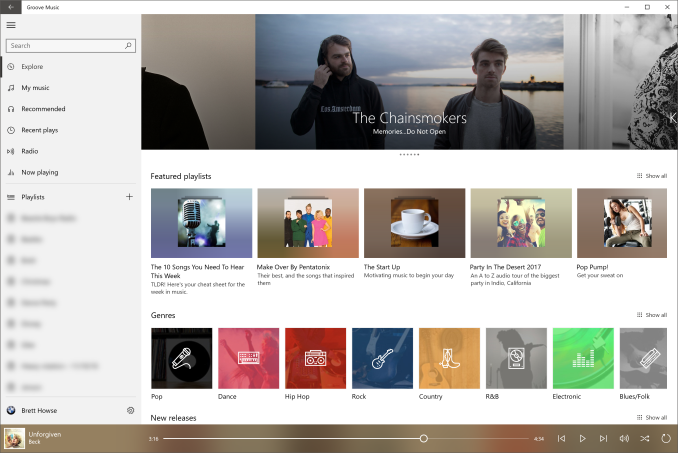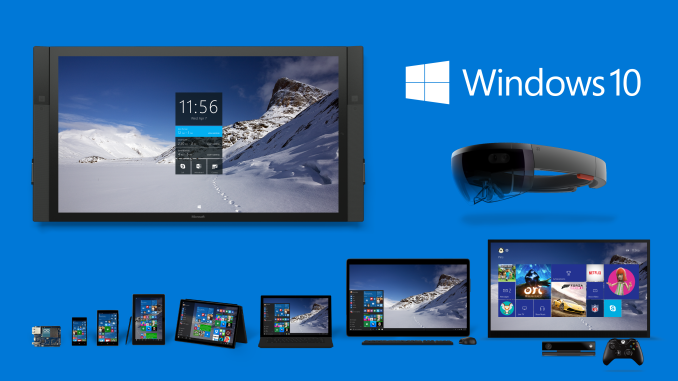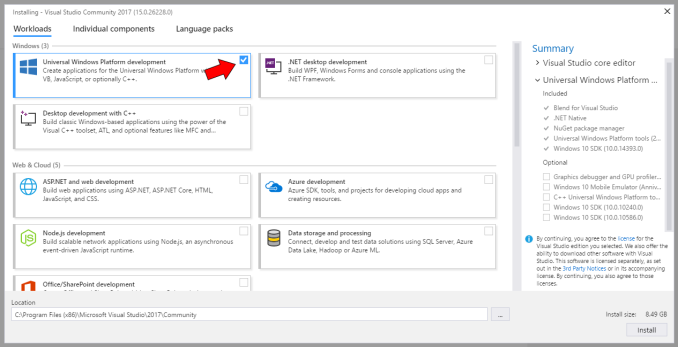The Windows 10 Creators Update Arrives
by Brett Howse on April 25, 2017 8:00 AM EST- Posted in
- Software
- Operating Systems
- Windows
- Microsoft
- Windows 10
Universal Windows Platform, now down a leg
For years, Microsoft was very clear about it’s ambitions to bring its platforms together, to give one single userbase to developers, rather than have to make apps for desktop, mobile, Xbox, Surface Hub, and eventually augmented reality. The efforts got serious in the Windows Phone 8 days, but it would still take several years for “Metro” apps to be morphed into the Universal Windows Platform (UWP). Microsoft promised a single platform for all of their apps, and they delivered. But it’s impossible to ignore their mobile play, which was floundering by the time they released Windows 10 Mobile.
Microsoft has all but abandoned their mobile efforts, instead embracing the dominant mobile ecosystems in Android and iOS, by bringing their apps to those environments. Sure, they still update Windows 10 Mobile, but with the Creators Update, only a handful of Windows 10 Mobile devices will be offered the update. It’s not a surprise, since Microsoft never really got any meaningful penetration in phones, but it certainly leaves UWP in an odd place. For years, Microsoft has been pushing UWP as a method to broaden application availability over multiple devices, but by abandoning their mobile strategy, it leaves them in a tough spot. UWP has suffered, perhaps partly because of this, but it certainly hasn’t gained the traction that Microsoft had hoped for. If it had, perhaps Windows 10 Mobile would not have been dead on arrival.
Without phone, UWP is now a tool to deploy apps across desktop, Xbox, Surface Hub, and mixed reality devices. But without a phone platform, that means that it’s basically just desktop. Even at just 5% phone usage share, phone would have been somewhere around 75-100 million devices. Xbox may eventually get there, but it’s going to be years, if ever. Surface Hub is a device that’s going to sell in the thousands, and Hololens is currently a developer-only item right now. That leaves the desktop, which is going to be the majority of the last official Windows 10 install base, pegged at 400 million devices at the end of September 2016. Expect a new figure to come soon, but regardless, almost all Windows 10 installs are on the PC.
That’s not necessarily a bad thing, although there are questions of where computing will go in the future, but for now, the PC is still the go-to device for most people when they need to get something done. But if one of your key points to pushing a new developer platform is cross-platform capabilities, but you only really have one platform that matters, it’s not ideal. Microsoft generally discusses upcoming developer news at their Build conference, which will be happening in May this year, so perhaps we will see some news there on where UWP goes from here.
The odd part about UWP and the cross-platform push that Microsoft has been doing for years, is that UWP could have been focused more on the desktop years ago, and improved to the point where it makes sense to use it on the desktop over older frameworks. But that push has never happened, despite some improvements to UWP.
Desktop has been held back by old app frameworks for years. Devices continue to improve, and older applications struggle to take advantage of High DPI displays, wide color gamuts, and more. UWP could have been the solution to this, but it was never sold as the solution to anything on the desktop. In fact, its limitations on the desktop are clear. Windows 10 brought the ability to run UWPs in a window on the desktop, but UWP is still treated as a mobile-first app platform, with all of the restrictions of a mobile device which is hampered by performance and power.
 Groove Music - a UWP Music app
Groove Music - a UWP Music app
Ideas that were spawned in the days of the push to mobile need to be abandoned, or at least add in options for developers to unlock more capabilities on the desktop. With 32 GB of memory in my desktop, I don’t really need apps frozen in the background when they aren’t the active window. With a desktop plugged into power, there is no reason a UWP can’t keep running all the time. Until desktop (and this includes laptops) becomes the focus of UWPs, the limited capabilities will restrict the apps that are brought to this framework, which means any benefits they would bring, such as touch support, share contract support, and high DPI capabilities, are going to be ignored for the more capable older frameworks.
Microsoft has done a lot of work to bring older applications to their store model, and that has been somewhat successful, especially with the Centennial bridge which allows Win32 apps to be converted to store packages, but at the end of the day, UWP needs to be a focus if they want it to succeed.












69 Comments
View All Comments
tvdang7 - Tuesday, April 25, 2017 - link
How are you going to report on game mode with no benchmarks :-)TheWereCat - Tuesday, April 25, 2017 - link
I did clean install of the W10 x64 Pro with Creators update this week and I must say that the game mode is a complete garbage (at least in my case).All my games were stuttering horribly at well over 100FPS, so I checked frame times and there were huge spikes from 6ms-8ms when it was running smooth to suddenly crazy 100ms-600ms spike about every 5s.
After I disabled Game Mode, Game Bar and Game DVR then everything went nice and smooth.
i7 4770k 4.5GHz, GTX 1060 6G, 2x8GB DDR3, 1440p.
negusp - Tuesday, April 25, 2017 - link
Exactly. I'm pretty sure this really has to do with the Game Bar/DVR rendering in some games.Running an i5-6200u- with Game Bar/Game Mode enabled my fps in games like Counter-Strike GO and War Thunder was on average a good 4-5 fps lower and frame drops were much more noticeable.
Nothing insane but I need all the fps I can get on such a weak setup.
MattMe - Tuesday, April 25, 2017 - link
I think there have been a few reports of random issues like this, as well as it hampering ratehr than improving performance.I get the impression that game mode was designed for low-spec machines that have a lot of bloatware etc installed, not for fresh install high-end gaming machines that are configured specifically for gaming.
Not that it's an excuse for it affecting your pristine install, just commenting on what I've read elsewhere.
ddriver - Tuesday, April 25, 2017 - link
Waiting on the "almighty creator of all" update. Seriously, regardless of what adjectives you decorate it with, it is still spyware adware garbage.MattMe - Wednesday, April 26, 2017 - link
I wrote a response, then noticed the username. Nearly got me!Aloonatic - Tuesday, April 25, 2017 - link
I just "updated" windows 10 and Minecraft had gone from 25 to 30 fps with shaders, resource packs etc ore update, to 5 or 6 fps, even with all the Game Mode stuff turned off.Aloonatic - Wednesday, April 26, 2017 - link
Well, is my face red...ish.It turns out the nvidia control panel settings had been reset so Minecraft was using integrated intel gpu instead of my nvidia card. I've still had to turn a few setting science, however, to run as it did before.
Thretosix - Wednesday, April 26, 2017 - link
Even in the article it claims the purpose wasn't so much to increase the top end of framerates. This will help older PCs more than anything that are running lower on resources as time goes on. What it is really doing is limiting background processes to increase albeit a minimal increase in performance. The article states you may get a few frames saved off the minimum frame rate. Nobody expected this to turn an unplayable game to acceptable performance. Perhaps they should have called this feature something else.TheWereCat - Wednesday, April 26, 2017 - link
Well, I don't really need it to increase my performance but I sure as hell don't want it to cause issues, which in my case it does.